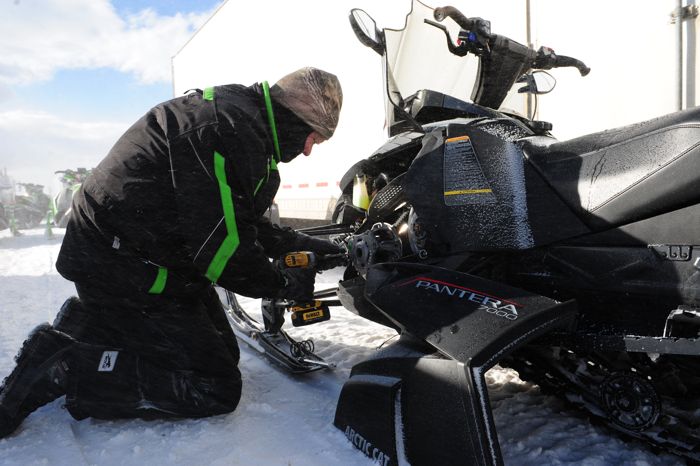
Arctic Cat is fortunate to have some of the most talented and experienced engineers in the entire snowmobile industry. One such engineer is Brent “Bart” Magner of Newfolden, Minn., whose role is to calibrate the clutching and gearing on all Arctic Cat snowmobiles. If you’ve owned an Arctic Cat snowmobile in the past 25 years, there’s a 99% likelihood that Magner was one of the guys responsible for the clutch calibration.
Magner is truly among the most talented snowmobilers I’ve ever ridden with, but you wouldn’t know it by talking with him: He’s a humble guy who would rather listen than talk (and, as you will see in the story, who NEVER looks at the camera when I shoot a photo of him). I feel pretty lucky that he agreed to do the interview.
Soon to celebrate his 30th year at Arctic Cat, the 49-year-old husband and father of four was gracious enough to talk about his job, the new TEAM clutches, racing with Larry Coltom and a bunch of other interesting stories.
AI: You have one of the coolest jobs in the world: riding and evaluating Arctic Cat snowmobiles in places throughout North America. What exactly is your job?
Magner: My title is Drive Engineer, and my role is to develop and determine the calibrations for clutching and gearing on all of our snowmobiles, at all elevations. I also verify our calibrations by testing one of each model production snowmobile as it comes off of the assembly line, usually on the asphalt track.
AI: That’s a substantial role you have, especially considering there are around 30 models and that you test at multiple elevations. Was this a pretty big year for you with the switch to TEAM clutches on so many models?
Magner: For sure, it was a big year for all of us on the Drive team. For the past few years our Arctic Cat clutches were pretty dialed-in and worked pretty great. We worked really hard to get the new TEAM clutches to be as good or better. We had a lot of help from TEAM, they’re a good company to work with.
AI: You make an important observation: that development of clutch calibration is an ongoing business. Talk about that.
Magner: You never stop improving on something, whether it’s clutch calibration, suspension, engine mapping. Every year we make incremental improvements over the previous year.
AI: Aren’t you also involved with more than clutching and gearing, because I’ve frequently seen you providing input on things like engine and suspension calibration?
Magner: Well first of all, I’m one of the drive engineers, along with Larry Coltom and the help we get from Gary Homme. Plus we get input and help from a lot of other Arctic Cat engineers – guys in the Engine department, suspension engineers, the guys at our Engineering facility in Island Park (Idaho, as well as from our supplier, TEAM Industries. Especially the Engine guys, because clutching and engine mapping go hand-in-hand.

By the same token, we as drive engineers give feedback to the other departments, which is why you’ve seen me working with those guys. There’s an incredible amount of knowledge and expertise in all of these departments and it’s important that it’s shared. We all have slightly different riding styles… little things like how hard you stab the throttle on take off, or whether you’re a rider who uses a lot of brake or not.
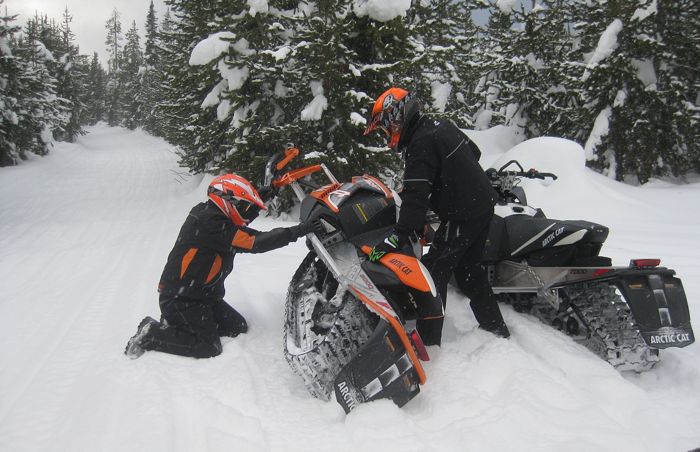
Each person feels and sees things on a snowmobile that can help as feedback for what I do. And it’s not just the engineers who have been doing this for decades; it’s also the new guys. We can get great feedback from new riders, because they ride differently than experienced riders. I think that crossover knowledge is why our sleds work pretty darn good.
AI: I agree with you. I’m always amazed by the ability of guys like you, who detect so many aspects of a snowmobile’s performance during a single ride. You get off of a sled after riding it for few minutes and rattle off five things it’s doing: “Clutching is heavy, the belt is a little worn, there’s a lean spot at 5000 RPM, there’s too much preload on the ski shocks, the track has a slight vibration.” I’m on that same five-minute ride and I maybe notice one thing about a sled. Like, “The hand warmers are nice.” (Laughter.)
Magner: It’s what we do every day, so we’ve learned to notice that stuff.
AI: Did you have any mentors who helped you learn this stuff?
Magner: For sure! I’ve been lucky to work with great teachers, some of the best in the sport. I’ve ridden almost every day with Larry Coltom, and working alongside him formed the base of all my snowmobile knowledge, not just clutching. He’s one of the best snowmobile and clutching guys in the world and a great teacher. Plus working with guys like Kim Chervestad, Dave Thompson, Roger Skime, Dennis Zulawski, Tubby Lund, Greg Spaulding, Donn Eide, Dean Lawrenz, Steve “Reno” Anderson, Kirk Hibbert… I’ve learned from the best.
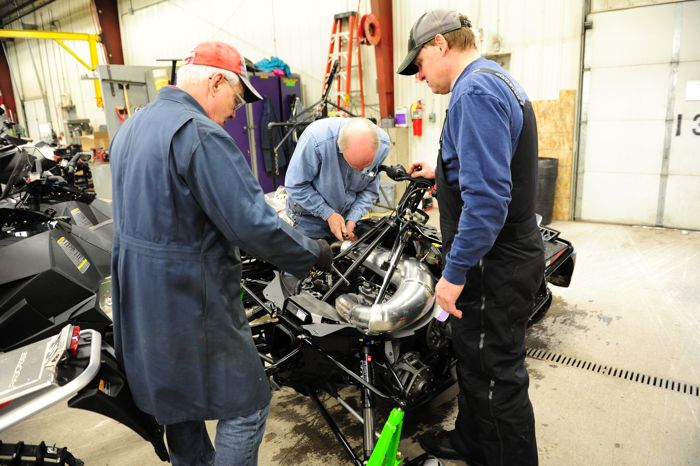
From L-to-R: Larry Coltom, Greg Spaulding and Bart Magner.
AI: That is a remarkable list of teachers! Did you start your career at Arctic Cat as a Drive Engineer, working with those guys?
Magner: No, I started on the assembly line in 1985. I worked there for four years, and then in the fall of 1989 I got a part-time role in Engineering, assisting Larry (Coltom) as a Drive Engineer. He needed help… basically he needed someone to drag race against, and a go-fer. (Laughs.)
Fortunately for me, Larry taught me clutching and calibration. Eventually I was working full-time as a Drive Engineer alongside him. Over the years, Larry stopped going out west to calibrate, so I got the responsibility for the mountain sleds. Eventually I became the lead Drive Engineer for all sleds.
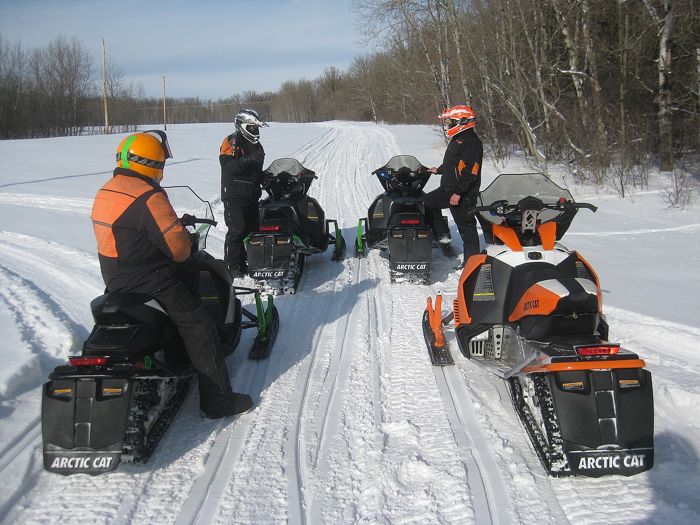
Bart (R) on an engineering test ride with Larry Coltom (L) and Jeff Olson.
AI: How much of your job is actual riding snowmobiles, and how much of it is shop and/or wrenching time?
Magner: It just depends on the day. Sometimes I change weights and cams all day long, doing just short bursts on the sled, and only ride 20 miles. Other days it might be 300 miles.
AI: What specifically are you trying to achieve with a good clutching and gearing calibration for a given snowmobile?
Magner: The sled needs to take-off smoothly, accelerate strong, be fast, maintain consistent RPM in all snow conditions. And it needs to do that all day, every day.
AI: How many miles do you typically ride in a season, and what’s the most you’ve ridden?
Magner: Really, I don’t have any idea. I ride so many different sleds and I don’t keep track. I probably get on 70 different sleds a year, of which 30 I’m directly responsible for. The riding season starts at end of November and goes through June. Plus I ride on the weekends, for work and for fun. But total miles? A lot, but I don’t know how many.
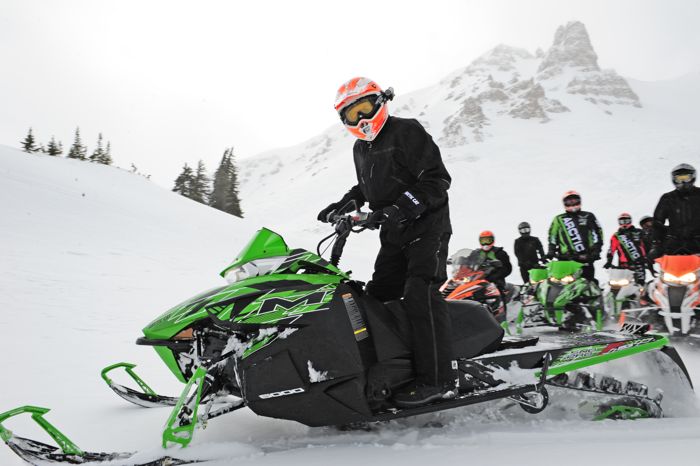
Bart, wearing his signature helmet cam, test riding snowmobiles in Idaho.
AI: What are some of the most interesting places you’ve ridden?
Magner: I get to ride in a lot great areas. Minnesota of course, but also Wisconsin, Michigan, Montana, Wyoming, Utah, Idaho, Colorado.
When the snow is good at the Grand Mesa in Colorado, it’s amazing. The whole area is phenomenal and everyone should go and ride there. One time we were there for 10 days, riding 6-8 hours per day and never went more than 5 miles from the trailer. The snow was so great that we didn’t have to go far.
I like riding anywhere if the snow is good. Island Park, Thompson, Manitoba and Cooke City. The mountains are great, but if you go make sure to use the correct backcountry safety equipment and take an avalanche safety classes.
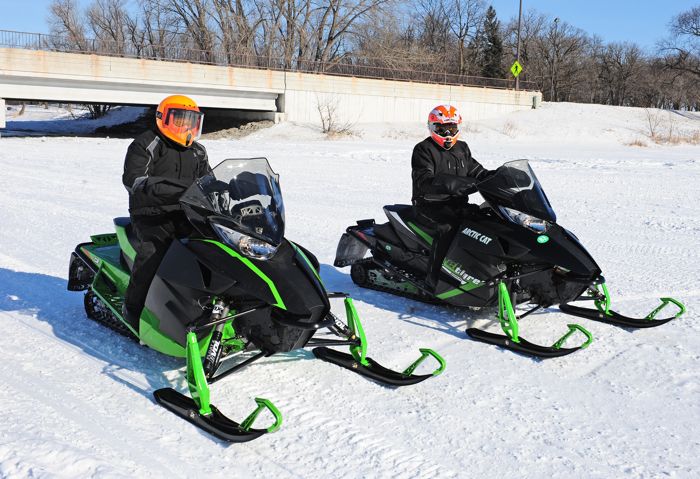
Heck, I love riding in the Warroad (Minnesota) area. There are some good trails going up to the Northwest Angle. It’s even fun riding on Lake of the Woods in the spring, when it’s glare, because it’s fun to go fast.
AI: You also raced successfully for a few years. Talk about that.
Magner: I raced cross-country for a couple years, 1993 and 1994, mostly the old ISOC circuit as well as some circuits up here and in Canada. I won every race that I finished in 1993, but I only finished four races. (Laughs.)
I quit because I didn’t have enough spare time to race. But in a way, I raced every day at work. (Laughs.)
Seriously, back then we’d do a fair amount of testing that would turn into races. That’s what happens when Larry is around, because he’s a super-competitive person. We’d each get one ZR440 and one ZR580. Larry always had to have the fastest sled of anyone, which is what makes him a good engineer. And if he wasn’t the fastest, then he wanted me to be the fastest, but nobody else.
Back then the guys in the race shop would occasionally test with each other – Joey Hallstrom, Kirk Hibbert and Al Shimpa – and we’d run into them on the river during the day, somewhere 50 miles or so from town. Joey would make some bet like, “First one back to TRF gets $50.”
Well, Larry and I would have the river absolutely dialed. Our sleds were always tuned perfectly, and Larry could absolutely ride a snowmobile as well as anyone. He and I would run nose-to-tail all the way into town to beat them. One time Shimpa crashed. We all stopped to make sure he was okay, then took off again for town.
Of course Joey never paid us the $50. (Laughs.)
AI: What’s your all-time favorite snowmobile, and why?
Magner: A 1981 Arctic Cat Pantera. Back in that year, my sister-in-law worked at Cat and got to use one. It was an awesome, beautiful sled. You could just go anywhere on it and not worry about it breaking down. We rode it like crazy. I was 14-year old kid and I thought a snowmobile couldn’t get any better than that ’81 Pantera.
AI: Have you always been into snowmobiling?
Magner: Oh yeah. We grew up riding snowmobiles. I remember back in middle school: I’d get home from school on the bus and would immediately run a couple blocks to the Highway 59 ditch, just to watch the Arctic Cat Field Test riders go by. It was the highlight of my day.
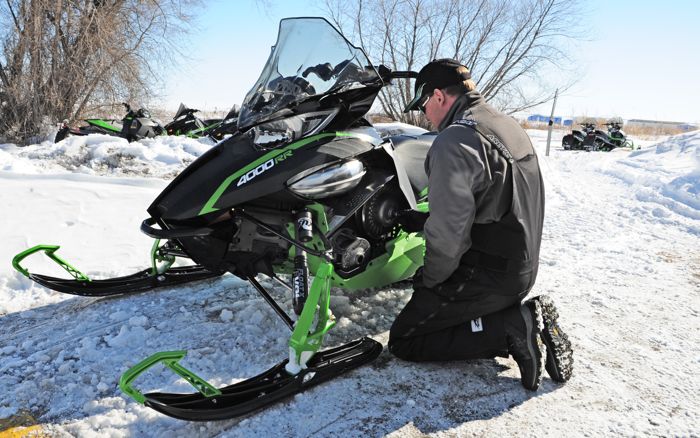
AI: That’s really cool! It’s funny how the first sled we fall in love with is usually our all-time favorite. If you didn’t have access to every single sled and were buying a new 2016 Arctic Cat, which would you choose and why?
Magner: That’s a tough question. Probably a ZR6000 with QS3 shocks. Or maybe a RR4000. That’s a great sled that is easy to have fun on.
AI: If you rode in the mountains all the time, would you go 141-, 153- or 162-in. track?
Magner: I’d probably go with a 153-in. track with 3-in. lugs. That track is awesome in the snow.
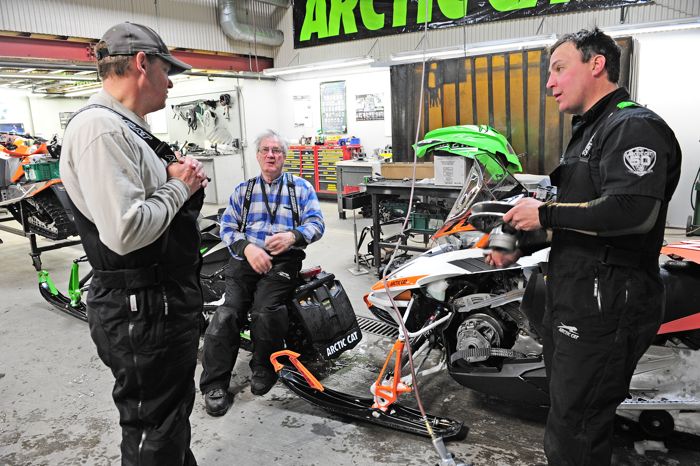
Bart (L) with Roger Skime (middle) and Brian Dick.
AI: Alright, let’s wrap this up with you telling us a good Roger Skime story.
Magner: I’ll tell you a story that occurred in about 1998 or 1999. There was 10-12 of us riding on the river near TRF. Roger was on my ZR 500, I was on a 600 and Larry was on a 500.
We’d stopped to talk for a bit. Then, all of sudden, Roger and Larry take off to race. I chased after them and a few miles later there’s a flurry of snow dust and Roger is off his sled from a crash. Somehow Larry’s track got on top of Roger’s skis, or Roger’s skis hit Larry’s track… but the end result was that Roger tumbled off his sled. Of course, the first thing I did was make sure my sled was okay. Then I went to check on Roger, whose first words were, “I think I broke my pooper.” (Laughs.)
He had to ride about 10 miles back to TRF to get to a doctor. Sure enough, he’d broken his tailbone.
There are hundreds of goofy little things that happen with Roger all the time. Half the time you don’t even recognize that it’s funny until after the fact.
Like a couple years ago, he and I were testing sleds at his farm. He’d just built this beautiful new shop, he’s this big rancher who is always talking about his herd and he has hundreds cattle all around. It was -20 degrees and we were both super hungry. So Roger says he’ll get us some beef. I’m thinking that it will be some fresh-cut meat, maybe a T-bone or something. But no, he comes back with these tiny, processed and packaged beef sticks…SlimJims or something. It didn’t add up. (Laughs.)
AI: Thanks for the great interview Bart, I appreciate it.
Magner: Your welcome, it was fun.
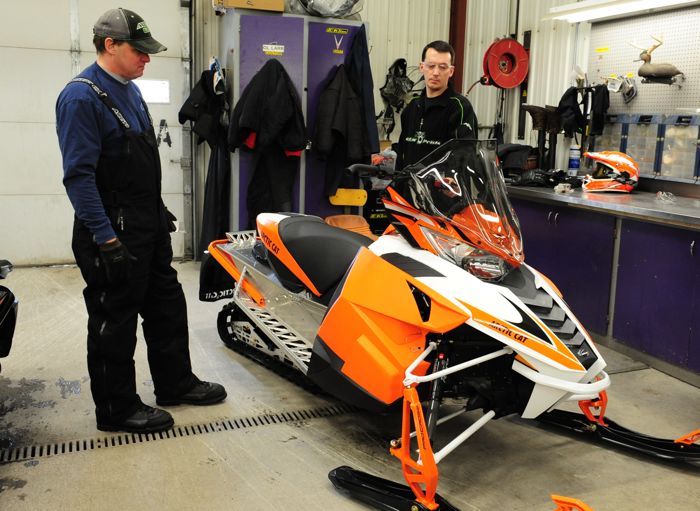
Bart (L) talking with Arctic Cat Snowmobile Product Team Leader Lynn Berberich.

Bart (R) talks with Engine engineer Greg Spaulding.
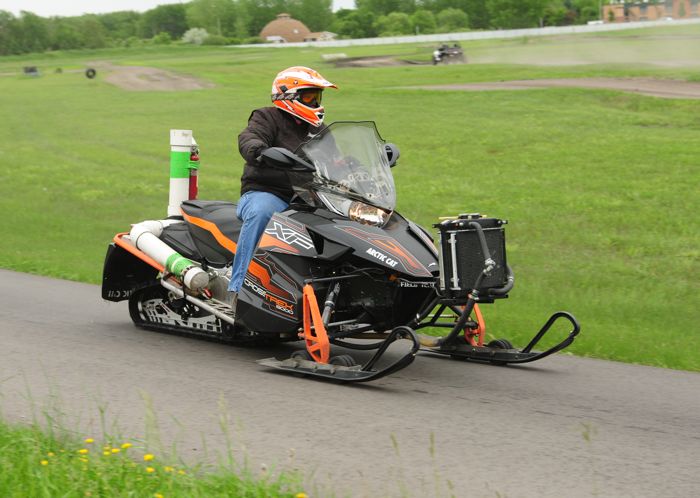
In addition to determining clutching/gearing calibration for new snowmobiles, Bart also does confirmation testing of production models when they come off the assembly line, like he’s doing here with a 2016 CrossTrek at the Arctic Cat test track.

Larry Coltom (L) and Bart doing a little work on a skidframe. Talk to Bart for 30 seconds about his job, and it will invariably include stories of Coltom, whom Bart credits as an incredible teacher about all aspects of snowmobiles.
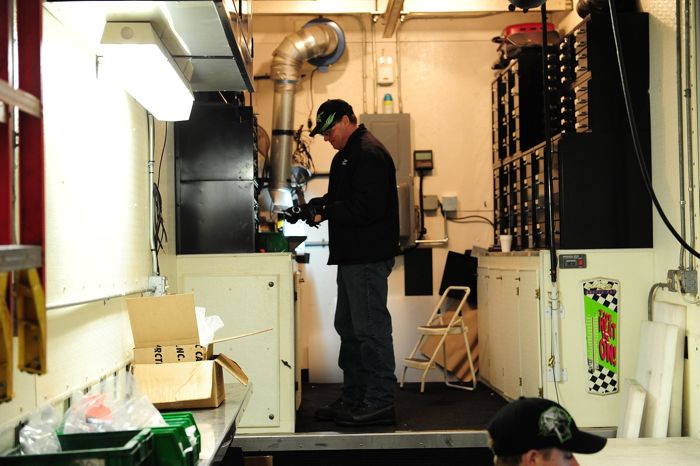
Bart grinding clutch weights inside the Arctic Cat Engineering trailer, something he’s done thousands of times during the past 25 years.


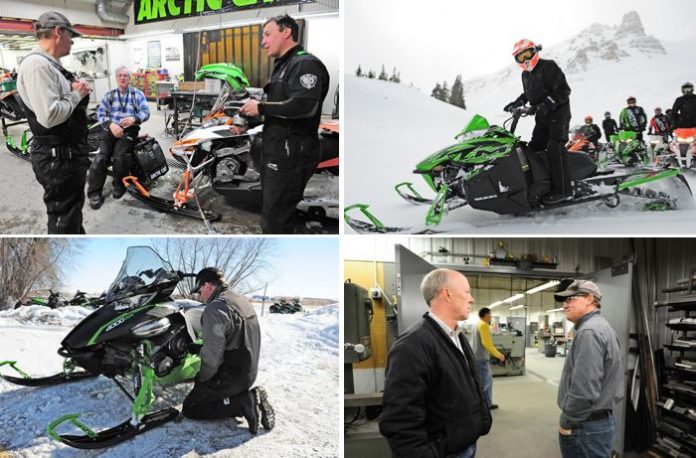
Who wants read about sleds in July? WE DO! Thanks again John, another great interview.
Great article again. Love the comments about the Grand Mesa. Lived there 5 years and it was great. I go back as often as I can. Keep up the good work.
Another cool factory write-up and interview John. Thanks
Thanks J ! I check your site often…Anxious for the next AC interview…My wife thinks I may need medication…I keep telling her…It’s a DNA thing…I’m from Minnesota, Swedish and ride sleds…I cannot change that ! 🙂
Nice article John on some pretty special guy’s….
great info in this one. bart sounds like hes a good person and likes his job.
Is the clutching calibration the same or different between models with the same engine but different track/packages? Like the ZR8 and the crosstek 8. Or bewteen the M8 and high country 8?
Thank you Bart for stepping out of your comfort zone to do this interview with John! Thanks for the great article and photos John.
Excellent article like always, keep up the fantastic work!
JayF: According to Bart, the clutching and gearing recommendations for same engine machines (such as M8000, ZR8000 and High Country 8000) are the same for various elevations. That means, if you use Cat’s recommended calibration for these models, it’s the same calibration for high elevation for the three.
However, these machines come from the factory with different calibrations because of where their assumed, primary usage takes place. ZR and High Country models come calibrated for low elevation, while M series come calibrated for high elevation.
ZR comes calibrated from the factory 0-3000 ft.
High Country and M are calibrated for 6-9000 ft from the factory
Need kit number 6639-589 if you want to ride the HC or M at low elevation.
Kit includes;
3 Cam Arms – 75g with set screw – 0746-672
1 Driven Cam – 42/40° – 0748-772
Changes the clutch calibration from factory 6000-9000ft to 0-3000ft
Fits Models;
2014-2015 M 8000
2014-2015 XF 8000 High Country
Yeah, that cheapskate cousin of mine…………………………
Have a question,. Seems my tank on my 2017 ZR 9000 has a lot of pressure in it. When I go to add gas, unscrew the cap and there is a lot of pressure that almost seems to pop the cap off. I was thinking of making my cap vented, will this be ok in doing so?